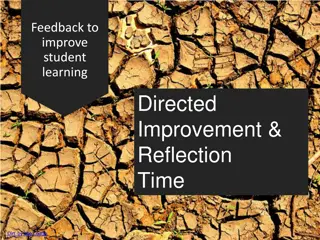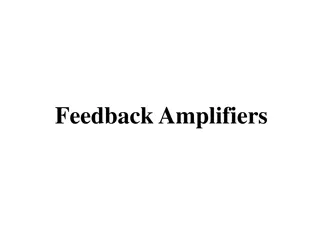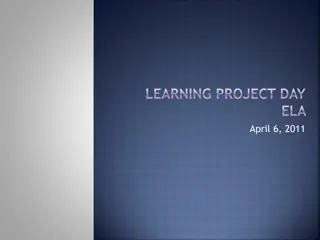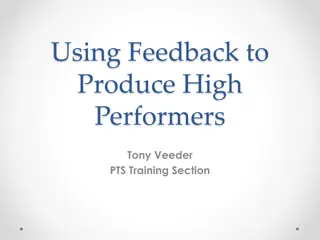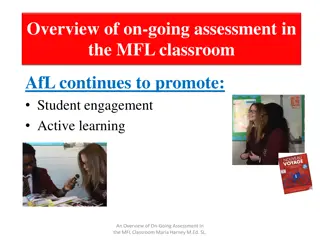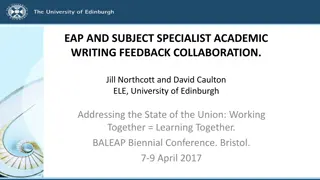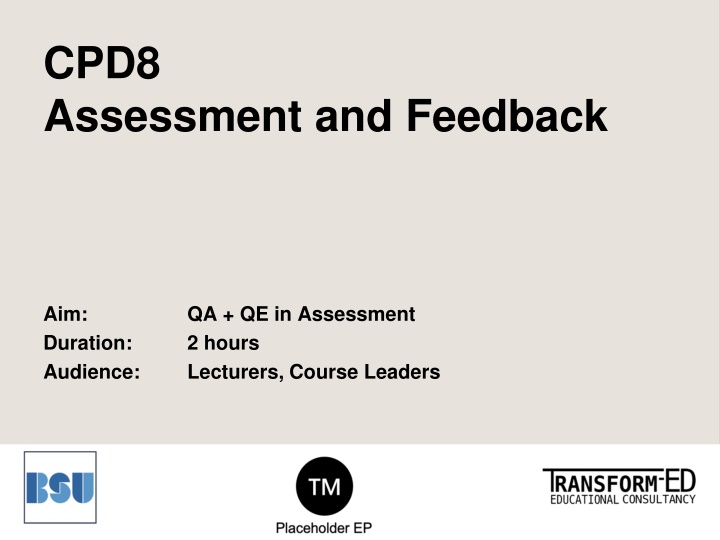
Effective Assessment Strategies for Educators and Course Leaders
Explore the importance of formative and summative assessment, best practices in assessment design, creating impactful feedback, and enhancing student experience. Learn how assessment informs teaching, engages students in learning, and supports academic achievement.
Download Presentation

Please find below an Image/Link to download the presentation.
The content on the website is provided AS IS for your information and personal use only. It may not be sold, licensed, or shared on other websites without obtaining consent from the author. If you encounter any issues during the download, it is possible that the publisher has removed the file from their server.
You are allowed to download the files provided on this website for personal or commercial use, subject to the condition that they are used lawfully. All files are the property of their respective owners.
The content on the website is provided AS IS for your information and personal use only. It may not be sold, licensed, or shared on other websites without obtaining consent from the author.
E N D
Presentation Transcript
CPD8 Assessment and Feedback Aim: Duration: Audience: QA + QE in Assessment 2 hours Lecturers, Course Leaders Placeholder EP
Learning Outcomes 1. Define formative and summative assessment and their role in the assessment process 2. Articulate best practice in the assessment design 3. Construct an assessment timeline to develop timed interventions to support student assessment 4. Discuss an approach for the construction of impactful and meaningful assessment feedback 5. Discuss elements which support a positive student experience and how these are measured as part of QA processes 2
Content Assessment for learning Summative and formative assessment Constructive alignment Holistic assessment Constructing good assessment feedback Good marking practice Moderation Feedback model 3
Why assessment? Enables teachers to use information about student s knowledge, understanding and skills to inform their teaching Teachers provide feedback to students about their learning and how to improve Assessment for Learning Involves students in the learning process where they monitor their own progress, ask questions and practise skills Students use self-assessment and teacher feedback to reflect on their learning, consolidate their understanding and work towards learning goals Assessment as Learning Assists teachers to use evidence of student learning to assess student achievement against learning goals and standards Assessment of Learning 4
Summative & Formative Does not count to a student s grade. Informs the completion of the summative task Helps to support student understanding of the assessment task. Can help with student pacing and meeting deadlines Engages students with the assessment criteria Can help to enhance module and degree performance. Formative assessment Counts to the module grade and potentially the final degree outcome. Links to the module specification and validation (cannot be changed without approval) Subject to intense QA and QE Needs clear management and student support. Requires clear understanding for all the markers Often requires external examiner approval Summative assessment 5
NUS Assessment charter (1) Formative assessment and feedback should be used throughout the programme. Students should have access to face-to-face feedback for at least the first piece of assessment each academic year. Receiving feedback should not be exclusive to certain forms of assessment. Feedback should be timely. Students should be provided with a variety of assessment methods. 6
NUS Assessment charter (2) There should be anonymous marking for all summative assessment. Students should be able to submit assessment electronically. Students should be supported to critique their own work. Programme induction should include information on assessment practices and understanding marking criteria. Students should be given a choice of format for feedback. 7
NUS Assessment & Feedback Tool https://www.qaa.ac.uk/docs/qaas/focus-on/nus-assessment-and-feedback-benchmarking-tool.pdf?sfvrsn=f37cf481_14 8
Designing assessment Decorative - front page of Bigg's report When designing and planning assessment for a module there are a number of important considerations to consider. A lot of these relates back to constructive alignment. See Biggs and Tang (2011) - Adapted from Biggs (1999) and Houghton (2004). This is where the teaching activities, student learning and assessment are aligned whereby the learning activities align with the ILOs and therefore the assessment. https://www.advance-he.ac.uk/knowledge-hub/aligning-teaching-constructing-learning 9
Holistic assessment Based on work from Uni of Herts & Greenwich. Green = lower stake | Amber = higher stake | red = high stake Assessments in a degree need to link together 10
(OfS) B4 Effective Assessment, Credible awards Students are assessed effectively Each assessment is valid and reliable Academic regulations are designed to ensure that relevant awards are credible Academic regulations are designed to ensure the effective assessment of technical proficiency in the English language Relevant awards granted to students are credible at the point of being granted and when compared to those granted previously. 11
(OfS) B5 Sector recognised standards Part A - Threshold standards: A1 Conventions for qualification titles at each level (4-8) A2 Typical volumes of credit for HE qualifications at each level (4-8) A3 Qualification descriptors Part B Classification descriptors Typical skills and attributes for each classification for Level 6 bachelors degrees 12
Assessment timeline Assessment launch & FAQs Formative assessment Drop-in support 1 2 3 4 5 6 7 8 9 10 11 12 Assessment check-in & iLO activity. Online forum via VLE Summative submission 13
Activity: Managing the journey Running module assessment is like being a project manager. Effective and planned communication is critical. Repetition and reinforcement are often required as well as signposting. Peer student and student agency are key areas to develop. Based on the timeline on the previous slide, discuss in groups activities, interventions or resources which can be developed and given to students. Put idea on a ppt slide as part of a co-creation activity. Present back to the group 14
Giving feedback to students We give feedback to students but unless they fail they are not able to re-submit their work - so how is the feedback useful? It needs to feed forwards to support future activities, modules and potentially employability. Importantly, and as part of the NSS, we need to support students to: Identify when they are receiving feedback (verbal, written, other) Develop feedback literacy Apply their feedback to their studies 15
Juwahs Seven principles (1) Facilitates the development of self-assessment (reflection) in learning. Encourages teacher and peer dialogue around learning. Helps clarify what good performance is (goals, criteria, expected standards). Provides opportunities to close the gap between current and [pursue] desired performance. Juwah et al. (2004) 16
Juwahs Seven principles (2) Provides opportunities to close the gap between current and [pursue] desired performance. Delivers high quality information to students about their learning. Encourages positive motivational beliefs and self-esteem. Provides information to teachers that can be used to help shape the teaching [diagnostic]. Juwah et al. (2004) 17
Giving feedback to students (1) SUBJECT FEEDBACK LOGISTICAL FEEDBACK STRATEGIC FEEDBACK This is feedback on their assessment and in particular in relation to the module learning outcomes and the assessment criteria. This is also feedback on their assessment but with a focus on the operational elements. For example, structure, spelling, grammar, referencing, formatting and other non-subject specific elements. This is where feedback should become feedforward and give students actions to enhance further their performance. It is about the work and not the student. Avoid I and You when giving this type of feedback unless the assessment modality requires it. Additionally, it is good practice to identify future modules and and assessment whereby they can deliver and target their actions. This is also a good place to link to their formative feedback. 18
Giving feedback to students (2) SUBJECT FEEDBACK LOGISTICAL FEEDBACK STRATEGIC FEEDBACK This is feedback on their assessment and in particular in relation to the module learning outcomes and the assessment criteria. This is also feedback on their assessment but with a focus on the operational elements. For example, structure, spelling, grammar, referencing, formatting and other non-subject specific elements. This is where feedback should become feedforward and give students actions to enhance further their performance. It is about the work and not the student. Avoid I and You when giving this type of feedback unless the assessment modality requires it. Additionally, it is good practice to identify future modules and and assessment whereby they can deliver and target their actions. This is also a good place to link to their formative feedback. 19
Good marking practice A clear rubric aligned to the institution s grading framework is essential (also share this with students). When marking, review a couple of pieces of work blind and then discuss the grades with the marking team to explore and confirm standards. Do no make personal judgements (avoid I ) and overall the grading is based on more than one person, Give clear constructive feedback knowing that it will be shared with others (staff, students, externals, online). Where possible, compare to previous year to maintain levels. 20
Marking and Moderation Information is covered in the BSU policy. Double marking - this is for non-written forms of assessment (for example presentations) where two assessors are normally involved in marking and agree the final mark. Second marking - this is strongly recommended for all substantial summative assignments such as dissertations and final projects. Once complete the two markers should discuss and agree a grade. Internal moderation is a process separate from marking and provides assurance that marking criteria have been applied appropriately. It should also reflect the shared understanding of the markers, and an approach which enables comparability across academic subjects . 21
Moderation (1) Internal Moderation by Partner Internal Moderation by BSU (normally completed by the Link Tutor) Accuracy (how closes to the target) Precision (how close to each other) External Moderation by External Examiner 22
Moderation (2) Information is covered in the BSU policy. (text from/adapted from the policy) Module Leaders have responsibility for ensuring that summative assignments are double-marked or second-marked where it is appropriate. This is subject to academic judgement and should be based on the guidance below. However, it should be noted that all summative assignments should be internally moderated. Where second marking has taken place, moderation is required where three or more markers are within the marking team to ensure consistency 23
Moderation- process (1) Internal moderation ensures that the marking of student assignments is rigorous, fair, reliable, consistent with the marking criteria, and that the grades/ marks awarded are at the appropriate standard. It should take place BEFORE provisional grades are released to students. All staff newer to marking should be supported and included in the processes. The Moderator is not entitled to amend individual marks. However, if Moderators have specific concerns, they should raise these with the original markers but have no right to overrule. 24
Moderation- process (2) Should such a dispute occur, with no resolution, a third marker should be invited to adjudicate. The external examiner should not act as another marker. Should feedback from the Moderator result in the original markers amending marks for students within the sample, all summative assignments for that cohort will be reviewed by the original markers to check for fairness and consistency of approach. Marks can be amended at the Subject Board and are therefore provisional until ratified by the Assessment Board 25
Moderation- process (3) Moderations should be based on a sample which comprises: typically 10% or a minimum of 8 assignments taken from the full range of marks awarded. All failed assignments should be moderated. If 8 or fewer assignments are available, all of these should be moderated. Samples should be taken to represent student work at every delivery location (including modules delivered at partner institutions) and every mode of study. Resubmitted work should also be moderated. 26
Moderation- partners (1) Partner institutions must ensure that their own internal processes for the approval of assessment tasks and the moderation of student output are rigorous and consistent with the University Assessment and Feedback Policy Arrangements for moderation by BSU, which must involve at least one member of University staff (usually the link tutor), should be agreed annually with the partner organisation and confirmed at School Quality Management Committees. All modules at partner institutions, will be sampled for moderation by the University. 27
Moderation- partners (2) When determining the sample size for BSU moderation of assessments marked by partner providers, the following criteria will be considered: (1) the length of time the partnership has been established (2) the length of time the programme has been in operation (3) any conditions for moderation as set out at the approval event (4) the experience of the lecturer marking the student output (5) the level of the module and contribution to the overall degree classification (6) the type of student output and the practicalities of implementing the moderation process e.g. art exhibitions and performances. 28
Thank You Your name Contact details 04 October 2024
References https://web.archive.org/web/20201212072520id_/https://www.uky.edu/~rsand1/china2018/texts/Bloo m%20et%20al%20-Taxonomy%20of%20Educational%20Objectives.pdf https://haqaa2.obsglob.org/wp-content/uploads/2020/11/2001_Anderson_A-taxonomy-for-learning- teaching-and-assessing.-A-Revision.pdf https://quincycollege.edu/wp-content/uploads/Anderson-and-Krathwohl_Revised-Blooms- Taxonomy.pdf https://s3.eu-west-2.amazonaws.com/assets.creode.advancehe-document- manager/documents/hea/private/resources/id477_aligning_teaching_for_constructing_learning_156 8036613.pdf https://www.enhancingfeedback.ed.ac.uk/documents/id353_senlef_guide.pdf https://www.bathspa.ac.uk/media/bathspaacuk/about-us/policies/academic-and- student/Assessment-and-feedback-policy.pdf 31
Just One Thing Think about the assessment you remember the most from when you attended university. Why do you remember this? What can you learn from this reflection? Was it a good or bad experience? 32

